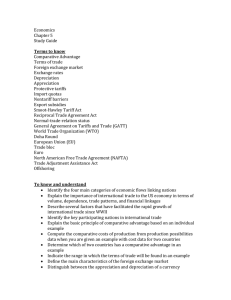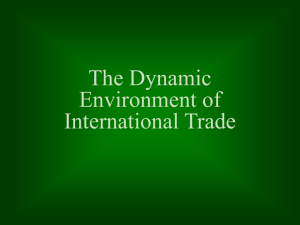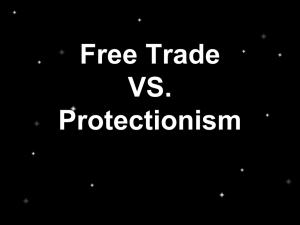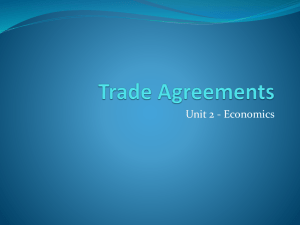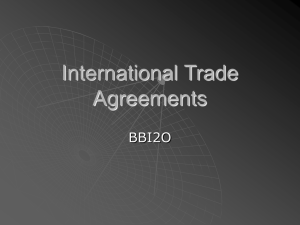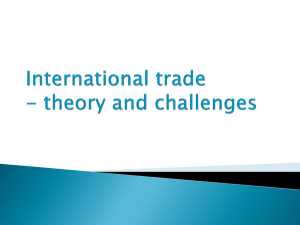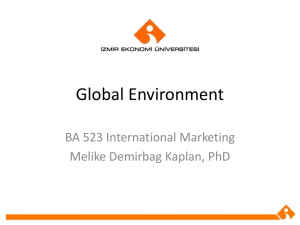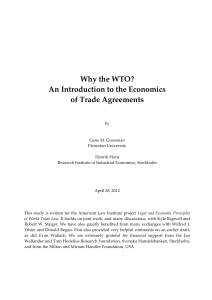Chapter 26 Section 4
advertisement
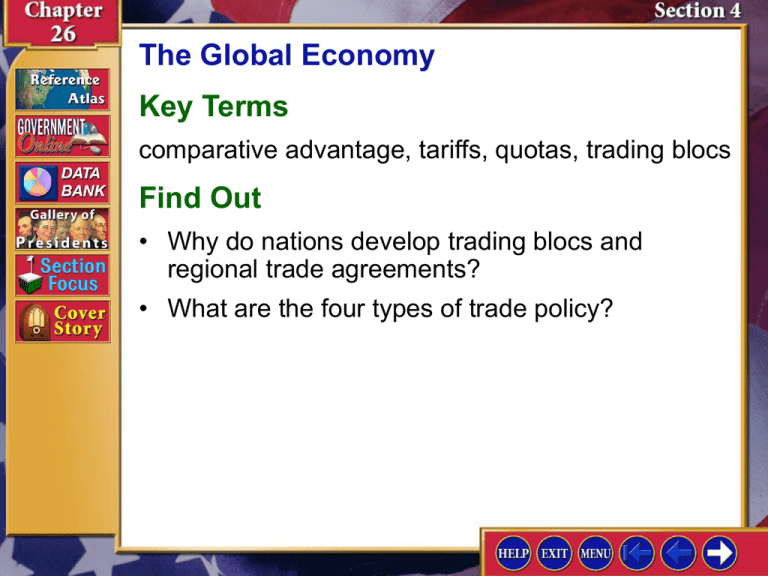
The Global Economy Key Terms comparative advantage, tariffs, quotas, trading blocs Find Out • Why do nations develop trading blocs and regional trade agreements? • What are the four types of trade policy? The Global Economy Understanding Concepts Global Perspectives How is the global economy making nations interdependent? Section Objective Analyze the factors that dominate global economic concerns today. In the late 1990s, South Korea experienced a sharp economic downturn. The International Monetary Fund loaned South Korea $57 billion to help strengthen its financial institutions and industrial corporations. South Korea’s problems threatened to spread to Japan and other nations with major trade with and investments in South Korea. The international effects of South Korea’s economic downturn demonstrated how interdependent nations have become in today’s global economy. I. International Trade (pages 732–734) A. The economic principle of comparative advantage says that each country should produce those goods it can make more efficiently and purchase those goods that other nations produce more efficiently; nations also trade to obtain goods and services that they cannot produce, and to create jobs. B. Governments limit or control international trade using barriers such as tariffs, quotas, non-tariff barriers, and embargoes; countries may also engage in unfair trade practices such as dumping. I. International Trade (pages 732–734) C. Economists look at a nation’s balance of trade—the measure of the entire flow of money in and out of a country—to measure a nation’s overall performance in the global economy. I. International Trade (pages 732–734) Explain your position on unrestricted international trade. Answers will vary. See International Trade on text pages 732–734 for a discussion of pros and cons. II. Trade Agreements (pages 734–735) A. Over 100 nations have signed the General Agreement on Tariffs and Trade (GATT) since it was first enacted in 1947 in an effort to reduce trade barriers. B. In 1994 GATT was replaced by a regulatory body known as the World Trade Organization (WTO), which hears complaints brought to it by member countries and has the authority to penalize nations that violate the GATT treaty. II. Trade Agreements (pages 734–735) C. The European Union (EU), currently made up of 15 European nations, is the world’s most important economic group; the EU achieved monetary integration with the adoption of the euro in 2002. D. In signing the North American Free Trade Agreement (NAFTA), the United States, Canada, and Mexico agreed to reduce and eventually end most trade restrictions among their nations. II. Trade Agreements (pages 734–735) How do you think European political and economic unification will affect the United States? Answers will vary. Some believe European unification will threaten U.S. world economic leadership. III. Trade Alternatives for the United States (pages 735–736) A. A pure free-trade policy would mean that businesses in different nations could buy and sell goods with no tariffs or other limitations of any kind. B. The goal of a fair trade policy is to create an orderly world market that does not give an unfair advantage to countries that use unfair business practices. C. With managed trade, government intervenes in trade arrangements in order to achieve specific results. D. Protectionism is the policy of using trade barriers to protect domestic industries from foreign competition and to prevent unrestricted trade. III. Trade Alternatives for the United States (pages 735–736) What challenges does globalization present to the American economy? Answers may vary but should include: the American worker must now compete with a much larger labor pool; economic and political decisions are now more complicated. Checking for Understanding 1. Main Idea Using a graphic organizer like the one below, identify factors that affect the stability of the global economy. Answers might include: free trade—quotas, tariffs, trading blocs; economic development— investment capital, stable markets, economic freedom, lack of national unity, military rule of government, rapid population growth Checking for Understanding Match the term with the correct definition. ___ C comparative advantage ___ D tariff ___ B quota ___ A trade bloc A. a group of nations that trade without barriers such as tariffs B. limit on the quantity of a product that may be imported C. economic principle that each country should produce those goods it can make more efficiently and trade for other goods D. a tax placed on imports to increase their price in the domestic market Checking for Understanding 3. Identify embargo, General Agreement on Tariffs and Trade (GATT), World Trade Organization (WTO). An embargo is an agreement prohibiting trade. The General Agreement on Tariffs and Trade (GATT) is a treaty that made an effort to reduce trade barriers. The World Trade Organization (WTO) is a regulatory body that replaced the GATT and enforces the provisions of the treaty. Checking for Understanding 4. Why do nations trade with one another? Nations trade with one another to exercise and benefit from comparative advantage. Critical Thinking 5. Drawing Conclusions Which type of trade policy do you believe is the most appropriate for the United States to follow? Why? Answers should be supported. Global Perspectives Trade is becoming more and more international, and countries are linking their economic fortunes with trade agreements. However, there are barriers to international trade. Review these barriers, and then prepare a plan for helping nations to overcome these barriers and build their international trade opportunities.
